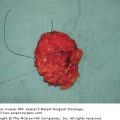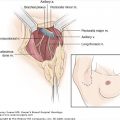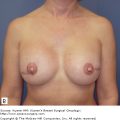The Eastern Cooperative Oncology Group (ECOG) has contributed a number of important research findings to the literature that are worthy of study by surgical oncologists. Large randomized trials have been performed by ECOG in conjunction with other cooperative groups, and pilot studies have been conducted within the confines of ECOG member institutions. Although many of the ECOG studies have focused on systemic treatment, a number of studies have generated information that is directly related to and of great significance for the local regional management of breast cancer. The current chapter reviews selected ECOG studies and discusses their implications for current surgical oncology practice.
Ductal carcinoma in situ (DCIS; intraductal carcinoma) is a non-obligate precursor of invasive carcinoma of the breast. Newly diagnosed DCIS is typically detected on routine screening mammography, most commonly from suspicious microcalcifications. Patients with such findings are frequently interested in breast conservation treatment, either with or without definitive radiation. Multiple prospective randomized trials have demonstrated that the addition of radiation treatment after lumpectomy (excision) significantly reduces the risk of local recurrence.1-7 This reduction in risk is approximately 50% for local recurrence, as well as for the subset of invasive local recurrence. This risk reduction can be further improved by the addition of adjuvant tamoxifen for hormone receptor–positive DCIS tumors, although a statistically significant benefit of tamoxifen was found in only 1 of 2 randomized clinical studies.2,3,6,8,9
Notwithstanding the substantial improvement in local recurrence associated with adjuvant radiation treatment, efforts continue to attempt to identify a subset of patients with favorable DCIS who are at a sufficiently low risk of local recurrence that the omission of radiation is reasonable. A substantial fraction of patients are treated in the United States using excision alone, without radiation treatment. Although retrospective studies have suggested the possibility of omitting radiation treatment in favorable patients, no prospective trial has definitively identified such a subset of patients.
In the early 1990s, ECOG developed E5194, a registration trial for presumably favorable DCIS lesions for treatment using excision alone without radiation. At the time of study development, a number of different criteria for selecting patients with DCIS for treatment using excision alone had been proposed in various retrospective institutional studies. Thus, although recognizing there was (and is) no uniformly accepted set of criteria for selecting favorable-risk patients for omission of radiation treatment after lumpectomy, the guidelines for entry into the ECOG protocol are reasonably similar to many, if not most, retrospective studies.
Selection criteria for enrollment into E5194 study were either (1) low- or intermediate-grade DCIS, ≤2.5 cm in size, or (2) high-grade DCIS, ≤1.0 cm in size. All patients were required to have pathologically confirmed negative margins of excision, with either a minimum negative margin width of at least 3 mm or no tumor on reexcision. Complete processing of the lumpectomy specimen was required. A central pathology review was performed, although eligibility for protocol entry was based on the original institutional pathology findings. A postbiopsy mammogram was required to confirm removal of all suspicious microcalcifications, if present on preoperative mammography. Patients entered into E5194 after 2000 were allowed the option to take adjuvant tamoxifen.
The findings from the ECOG E5194 study have been reported.10 The patients entered into the trial were heavily weighted toward more favorable characteristics, as evidenced by a minimum negative margin width of ≥10 mm or no tumor in the reexcision for 48.5% of the lower-risk group (low or intermediate grade) and 53.3% of the higher-risk group (high grade), as well a median tumor size of 6 mm in the lower-risk group and 5 mm in the higher-risk group. With a median follow-up of 6.2 years, the 5-year rate of ipsilateral local recurrence for the 565 eligible patients in the lower-risk group was 6.1% (95% confidence interval [CI] of 4.1% to 8.2%), and the 7-year rate was 10.5% (95% CI, 7.5% to 13.6%). With a median follow-up of 6.7 years, the 5-year rate of local recurrence for 105 patients in the higher-risk group was 15.3% (95% CI, 8.2% to 22.5%), and the 7-year rate was 18.0% (95% CI, 10.2% to 25.9%).
The data from this study suggest that the higher-risk group is not suitable for treatment using excision alone, without radiation treatment. For the lower-risk group, the 5- and 7-year results need to be interpreted cautiously in view of the relatively short follow-up period and the increasing risk of local recurrence beyond 5 years, albeit with wide CIs. The shapes of the local recurrence curves in the ECOG E5194 study are similar to the findings from a collaborative multi-institutional study of 268 patients treated with lumpectomy plus radiation treatment.11 In this latter study, higher-risk lesions were compared to lower-risk lesions on the basis of pathologic findings (comedo subtype plus nuclear grade 3 versus other, respectively). There was an early rise for the higher-risk group compared with the lower-risk group at 5 years (12% versus 3%, respectively) with the 2 curves approaching each other at 10 years (18% versus 15%, respectively; p = 0.15), similar to the E5194 study. Thus additional follow-up for patients in E5194 will be needed to determine the long-term rate of local recurrence in the lower-risk group and whether this rate of local recurrence will be acceptable to patients and physicians in clinical practice.
Historical guidelines for the recommendation to deliver postmastectomy radiation treatment include 4 or more positive axillary lymph nodes or pathologic tumor size more than 5 cm.12,13 However, the value of postmastectomy radiation treatment for the subset of patients with 1 to 3 positive axillary lymph nodes and pathologic T1 to T2 tumors remains an area of controversy. No prospective randomized trial data directly address this large and important subset of node-positive breast cancer patients, although indirect data come from subset analyses of prospective randomized trials.
In the Danish Breast Cancer Group (DBCG) and British Columbia randomized trials of postmastectomy radiation treatment, significant improvement for both local control and survival was demonstrated for the subset of patients with 1 to 3 positive axillary lymph nodes, as well as for the subset of patients with 4 or more positive axillary lymph nodes.14,15 Some studies, including the DBCG and British Columbia randomized studies, have been criticized for having a very high baseline risk of local regional recurrence for the groups of patients without postmastectomy radiation treatment, which, in turn, suggests that the value of postmastectomy radiation treatment may have been overestimated by compensating for inadequate surgery. To attempt to correct for this potential bias, subset analysis from the DBCG 82 b&c trials was limited to patients with a minimum of 8 lymph nodes evaluated (ie, likely to have had adequate surgery).15
In the Oxford overview of randomized clinical trials, mathematical modeling of the data demonstrated that the value of adding postmastectomy radiation treatment to reduce local regional recurrence was directly proportional to the baseline risk of local regional recurrence without radiation.16 For the patient with a given risk of local regional recurrence (without radiation treatment), the addition of radiation treatment reduced the risk of local regional recurrence by approximately two-thirds with a further reduction of approximately a quarter for breast cancer mortality. Thus the absolute improvements for local regional recurrence and breast cancer mortality can be calculated for an individual patient or patient subset by determining the baseline risk of local regional recurrence after mastectomy without radiation treatment.
The prospective, randomized Intergroup trial S9927 had previously been opened under the leadership of the Southwest Oncology Group (SWOG) specifically to test the value of postmastectomy radiation treatment for the subset of patients with 1 to 3 positive axillary lymph nodes and pathologic T1 to T2 tumors.17 However, this randomized trial closed prematurely because of inadequate patient accrual.
With the background described, ECOG analyzed the results for patients treated with mastectomy plus adjuvant CMF (cyclophosphamide, methotrexate, and 5-fluorouacil) chemotherapy, with or without tamoxifen.18 Analysis was limited to 2016 patients who had not undergone postmastectomy radiation treatment. The goal of this study was to determine the risk of local regional failure at 10 years without postmastectomy radiation treatment, both for the overall group of patients and for clinically relevant subsets of patients. The median follow-up for patients without recurrence was 12.1 years (range = 0.07 to 19.1 years). The median number of lymph nodes evaluated was 15, and 79% of the patients had more than 10 lymph nodes evaluated.
The ECOG analysis demonstrated that the 10-year risk of local regional failure (with or without simultaneous distant failure) at 10 years was 12.9% for patients with 1 to 3 positive axillary lymph nodes, and 28.7% for patients with 4 or more positive lymph nodes.18 Tumor size, number of involved lymph nodes, estrogen receptor status, and number of examined lymph nodes correlated with the risk of local regional failure on multivariate analysis.
One of the important aspects of the ECOG study was the detailed analysis of the risk of local regional recurrence by narrowly defined subsets of patients (Table 49-1). The value of the table is to facilitate clinical decision making by estimating the baseline risk of local regional failure (without radiation) for an individual patient, in particular, with a pathologic T1 to T2 tumor and 1 to 3 positive axillary lymph nodes. In contrast, most other studies have combined these patients into a single subset, which renders decision making difficult, if not impossible, for individual patients.
Stay updated, free articles. Join our Telegram channel

Full access? Get Clinical Tree







